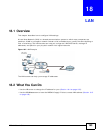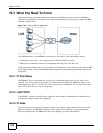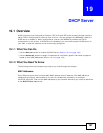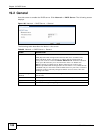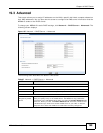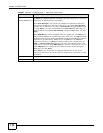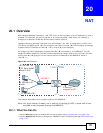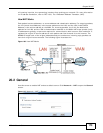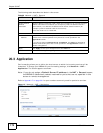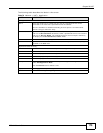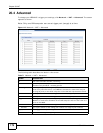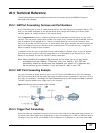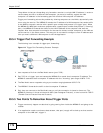
NBG4615 User’s Guide 171
CHAPTER 20
NAT
20.1 Overview
NAT (Network Address Translation - NAT, RFC 1631) is the translation of the IP address of a host in
a packet. For example, the source address of an outgoing packet, used within one network is
changed to a different IP address known within another network.
The figure below is a simple illustration of a NAT network. You want to assign ports 21-25 to one
FTP, Telnet and SMTP server (A in the example), port 80 to another (B in the example) and assign
a default server IP address of 192.168.1.35 to a third (C in the example).
You assign the LAN IP addresses to the devices (A to D) connected to your NBG4615. The ISP
assigns the WAN IP address. The NAT network appears as a single host on the Internet. All traffic
coming from A to D going out to the Internet use the IP address of the NBG4615, which is
192.168.1.1.
Figure 108 NAT Example
This chapter discusses how to configure NAT on the NBG4615.
Note: You must create a firewall rule in addition to setting up NAT, to allow traffic from
the WAN to be forwarded through the NBG4615.
20.1.1 What You Can Do
•Use the General screen to enable NAT and set a default server (Section 20.2 on page 173).
•Use the Application screen to change your NBG4615’s port forwarding settings (Section 20.3 on
page 174).
A: 192.168.1.33
B: 192.168.1.34
C: 192.168.1.35
IP address
192.168.1.1
WANLAN
assigned by ISP
FTP, Telnet, SNMP
Port 80
Ports 21 to 25



